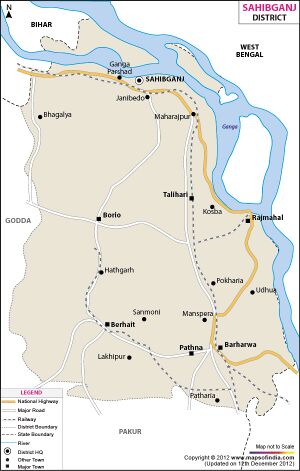Kankjol
| Author:Laxman Burdak, IFS (Retd.) |

Kankjol (कजंगल) was one of the Buddhist places visited by Xuan Zang in 639 AD. Alexander Cunningham[1] has identified Kankjol with Rajmahal city in Sahibganj district in Jharkhand.
Variants
- Ugamahala (उगमहल) (संथाल परगना, बिहार) (AS, p.86)
- Rajamahala (राजमहल) दे. Ugamahala (उगमहल), और Kajangala (कजंगल) (AS, p.782)
- Kajangala (कजंगल) (AS, p.125)
- Kajugiri कजुगिरि दे. Kajangala कजंगल (AS, p.125)
- Kanjugiri (कंजुगिरि) = Kajangala (कजंगल) (AS, p.125)
- Kankajola (कांकजोल) = Kajangala (कजंगल) (AS, p.154)
Location
Jat clans
History
उगमहल
विजयेन्द्र कुमार माथुर[2] ने लेख किया है ...उगमहल (AS, p.86) बिहार प्रांत के राजमहल का मध्ययुगीन नाम है। मुग़ल बादशाह अकबर के मुख्य सेनापति राजा मानसिंह ने 1592 ई. में उगमहल के स्थान पर राजमहल को बसा कर उसे बंगाल प्रांत की राजधानी बनाया था। उगमहल का प्राचीन नाम 'कजंगल' हुआ करता था। अकबर के वित्तमंत्री राजा टोडरमल के अभिलेखों में भी उगमहल का उल्लेख मिलता है। 1639 से 1600 ई. तक राजमहल में बंगाल के शासन की राजधानी रही थी। प्राचीन नगर के खंडहर 4 मील पश्चिम की ओर हैं, जिनमें कई मुग़लकालीन प्रासाद और मस्जिदें हैं।
कजंगल
विजयेन्द्र कुमार माथुर[3] ने लेख किया है ...कजंगल (AS, p.125) पश्चिम बंगाल में स्थित एक ऐतिहासिक स्थल है। यह विस्तृत पहाड़ी क्षेत्र अंग के पूर्व में स्थित था। राजमहल बंगाल का प्राचीन नाम था। हर्षकाल (630 ई. के लगभग) यहां एक स्वतंत्र राज्य था, किंतु महाराज हर्ष के प्रभाव कर अंतर्गत था। महावग्ग में इसे महाशाल नामक ब्राह्मण गाँव के आगे मध्य देश की पूर्वी सीमा बताया गया है। मिलिन्दपन्हो के अनुसार यह एक ब्राह्मण गाँव था, जो प्रसिद्ध बौद्ध दार्शनिक नागसेन का जन्म स्थान था। अंगुत्तर निकाय में उल्लेख है कि महात्मा बुद्ध यहाँ आये थे। कजंगल का युवानच्वांग ने का-चु-वेन-की-लो के रूप में उल्लेख किया है। चीनी यात्री ने लिखा है कि महाराज हर्षवर्धन ने अपनी पूर्वी देशों की विजय- यात्रा में हर्ष ने राजसभा की थी। चीनी यात्री यहाँ से पुण्ड्रवर्धन गया था। कजंगल के कंजुगिरि, कांकजोल आदि नाम भी उपलब्ध हैं। मध्ययुग में इसे उगमहल भी कहा जाता था।
Visit by Xuanzang in 639 AD
Alexander Cunningham[4] writes that from Champa the pilgrim Xuanzang travelled to the eastward for 400 li, or 67 miles, to a small district named Kie-chu-u-khi-lo, or Kie-ching-kie-lo[5] The distance and bearing bring us to the district of Rajmahal, which was originally called Kankjol, after a town of that
[p.479]: name which still exists 18 miles to the south of Rajmahal. Following the river route via Kahalgaon (Colgong) and Rajmahal, the distance from Bhagalpur is just 90 miles ; but by the direct route through the hills, via Mangaon and Bharhat, the distance is under 70 miles. As this position agrees with that of the place indicated by Hwen Thsang, I suspect that there may have been a transposition of two syllables in the Chinese name, and that we should read Kie-kie-chu-lo, which is a literal transcript of Kankjol. In Glad-wyn's translation of the 'Ayin Akbari'[6] the name is read as Gungjook, but as all the names are given alphabetically in the original, it is certain that the first letter is a k; I conclude, therefore, that the true name is Kankjol, as the final I might easily be misread as a k. In his Gazetteer, Hamilton[7] calls the place Caukjole, which is probably a misprint for Cankjole. He notes that the district of Rajmahal was formerly "named Akbarnagar from its capital, and in the revenue records Caukjole, as being the chief military division."
Hwen Thsang estimates the size of the district at 2000 li, or 333 miles, in circuit ; but as it was a dependency of one of the neighbouring kingdoms it was probably included, as I have already noted, in the area of the dominant state. When independent, the petty state of Kankjol most probably comprised the whole of the hill country to the south and west of Rajmahal, with the plains lying between the hills and the Bhagirathi river as far south as Murshidabad. The circuit of this tract would be about 300 miles, as stated by Hwen Thsang.
See also
References
- ↑ The Ancient Geography of India: I. The Buddhist Period, Including the Campaigns of Alexander, and the Travels of Hwen-Thsang. By Sir Alexander Cunningham, p.478-479
- ↑ Aitihasik Sthanavali by Vijayendra Kumar Mathur, p.86
- ↑ Aitihasik Sthanavali by Vijayendra Kumar Mathur, p.125
- ↑ The Ancient Geography of India/Champa, p.478-479
- ↑ Julien's ' Hiouen Thsang,' iii. 73. See Map No. I.
- ↑ 'Ayin Akbari,' ii. 178.
- ↑ 'Gazetteer of India,' in v. Rajamahal

